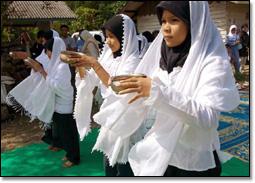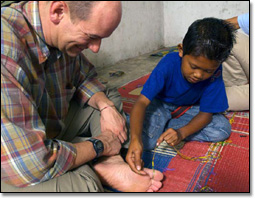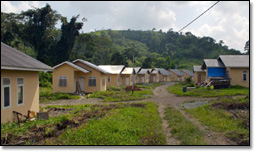Bob Seipel, a program manager for Boeing Space & Intelligence Systems Mission Systems, is reporting for Boeing News Now this week from Banda Aceh, Indonesia. He is part of a delegation led by the company's Global Corporate Citizenship function to investigate the progress of the rebuilding in Aceh province on the island of Sumatra, one of the areas hit hardest by the December 2004 Southeast Asian tsunami.
Boeing employees and retirees' donations accounted for nearly $2 million of the total Boeing contributions of $4.5 million split among three international relief agencies -- the American Red Cross, Mercy Corps and CARE, the latter two of which are sponsoring this site investigation. It is Seipel's responsibility on this trip to be the eyes and ears of Boeing employees and retirees who gave so generously to this disaster and to report back on how their dollars and those of the company are being spent in the relief efforts.
Each days events: Day 1, Day 2, Day 3, Day 4, Day 5
Day 4, FEB 1:
Far from home, but home all the same

The Boeing group's visit to Saree begins with a traditional Acehnese welcome song and dance performed by a troupe of girls. (Photo courtesy of CARE)
Imagine having to abandon everything you know, your way of life, and how you make your living. You resettle in an unfamiliar place, among people who are mostly strangers. Add to that the fact that you've also lost many of your loved ones.
That's just what happened to the people we met today during our first full day with our CARE guides. We traveled to a place called Saree to visit with refugees from a remote island off the west coast of Sumatra called Pulo Aceh. The tsunami swallowed this island when it hit, killing about 40 percent of the population and leaving the land unusable and partially underwater. The survivors escaped on rafts to the mainland and walked for miles until they found help.
Thanks to CARE, the entire group has stayed together as it awaits new housing and new lives. CARE has been working with the local government for the past 18 months to find a suitable location for the new village, clear land, conduct environmental assessments and build.
Previously, the main source of income and food for the islanders had been fishing. Now they live far inland and have had to find other ways to make a living. Many are learning farming, while some are becoming shopkeepers or learning trades such as furniture making and motorcycle repair. In contrast to fishing, where they caught what they could eat and sell on a day-to-day basis, farming is a more long-term process that requires many months to realize any benefits. It's a tough adjustment.
Many of the people we met hadn't known one another before the disaster, but you can feel the bond that has grown among them since then. Even though a majority of the houses CARE is building are complete, no one wants to leave anyone behind in the barracks they are living in now. And when the hundreds of families were given a choice of 12 designs for their new homes, they decided as a group to pick only one so that everyone would have the same thing.
That feeling of a shared destiny extends to the children in the group who were orphaned after the tsunami hit. We met one 12-year-old girl whose mother was literally ripped from her arms by the force of the waves. She also lost her father and the rest of her siblings. She wasn't able to speak for six months. We are told she still cries when she thinks of that horrible day. But while she lost one mother, she now has many. She is not alone; she is cared for and loved.

When making bracelets from string, the children often secure the small loop at the end of the string around their toes if they have no one to hold it for them. One boy shows Boeing's Bob Seipel this technique by using Seipel's big toe as an example. (Photo courtesy of CARE)
We saw no signs of mourning during our visit. In fact, the mood was joyful. We were greeted with a traditional Acehnese welcome song and dance performed by a group of girls. The women had prepared a large feast of traditional Acehnese food in our honor, being careful to make everything much less spicy than it normally would be.
The entertainment and food were part of a celebration of the one-year anniversary of the establishment of a women's group CARE helped facilitate through its Psychosocial Project. The women named their group Kembang Seroja after a beautiful native flower that symbolizes hope. By all accounts, CARE's Psychosocial Project has helped to restore this feeling.
The project, which is being replicated in other areas of the world, encourages the women survivors in particular to share their experiences and their tremendous grief so their collective load can be lightened. The CARE workers have found that when the women are helped in this way, the whole family benefits. One worker said a man had told her his wife seemed happier after these sessions and that they have a closer connection overall.
Children are kept occupied elsewhere during the women's sessions with arts and crafts projects that keep their hands busy while teaching social skills. CARE has also developed a series of comic books that feature stories about the lives of tsunami survivors to help the children deal with their memories.
We sat in on one of the childrens' projects during our visit. With just a few strands of colorful string, they made intricate bracelets, which they tied around our wrists as gifts. The children secure the small loop at the end of the string around their toes as they tie it if they have no one to hold it for them. One boy showed me this technique by using my own big toe as an example.

Tidy rows of what will eventually total 230 new houses wait only for final touches and hookup to the main water supply before their new owners can move in. (Photo courtesy of CARE)
After lunch, we witnessed what CARE calls a "drama" in which children and adults role-play about who to tell and what to do if they find a sick or dead bird suspected of avian flu. The children acted out finding a bird, washing their hands and telling an adult responsible for a situation such as this. The drama ended with one of the women feigning sickness and a group taking her down the road to a clinic. Something as simple as this playacting may be key in limiting the future spread of the illness to humans. As of this date, no human case of avian flu has been reported in the province.
We thanked our hosts and traveled a few miles up a bumpy road to where the permanent housing for the village is being built. There we saw tidy rows of what will total 230 new light-yellow houses nestled into the green, rolling hills, waiting for final touches and hookup to the main water supply before their owners move in and start their new lives.
As we walked back toward our cars, we could almost hear the children we had just met laughing and running around the streets of their new neighborhood; safe, sound and happy.
For more information about CARE's efforts in Banda Aceh and other tsunami-affected areas in the region, visit the organization's Web site.
|

